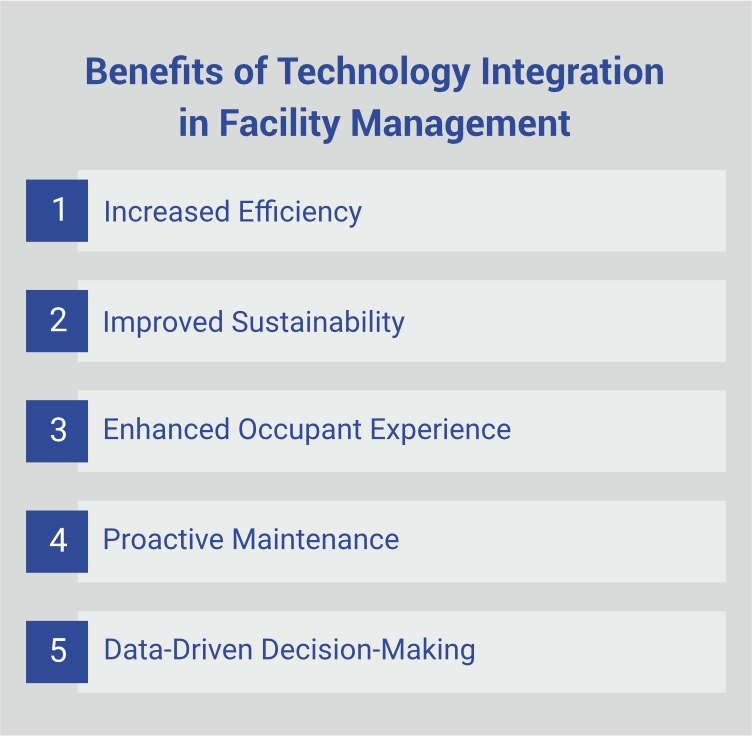Introduction:
Integrated Facility Management (IFM) is undergoing a significant transformation with the integration of cutting-edge technologies. From smart building technologies and the Internet of Things (IoT) to data analytics and predictive maintenance, technology is reshaping how facilities are managed, improving efficiency, reducing costs, and enhancing the overall experience for occupants. In this blog, we will delve into the pivotal role of technology in IFM and explore the various advancements that are driving this evolution.
Smart Building Technologies
Smart building technologies are revolutionizing the way Facility Management Companies in India operate. These technologies leverage automation and connectivity to create more efficient, sustainable, and comfortable environments. Key components of smart building technologies include:
1. Building Management Systems (BMS):
BMS are centralized systems that monitor and control building services such as HVAC, lighting, security, and fire safety. They enable Facility Management services providers to optimize energy consumption, improve operational efficiency, and ensure a safer environment for occupants.
2. Energy Management Systems (EMS):
EMS helps in monitoring and managing energy usage within a facility. By analyzing energy consumption patterns, facility managers can identify inefficiencies and implement strategies to reduce energy costs, contributing to sustainability goals.
3. Smart Lighting Systems:
Smart lighting systems use sensors and automation to adjust lighting levels based on occupancy and natural light availability. This not only reduces energy consumption but also enhances the comfort and productivity of occupants.
4. Advanced Security Systems:
Facility Management Solutions are increasingly incorporating advanced security systems, including biometric access control, surveillance cameras, and intrusion detection. These systems enhance security and provide real-time monitoring and alerts.
IoT and Facility Management
The Internet of Things (IoT) is playing a critical role in the evolution of Facility Management in India. IoT devices and sensors are embedded in various building systems, providing real-time data that facility managers can use to make informed decisions.
1. Real-Time Monitoring:
IoT-enabled devices allow for real-time monitoring of critical building systems. This enables facility Management service providers to identify issues before they escalate, ensuring minimal disruption and optimal performance.
2. Predictive Maintenance:
Predictive maintenance uses IoT sensors to monitor the condition of equipment and predict when maintenance is needed. This proactive approach helps in reducing downtime, extending the lifespan of assets, and lowering maintenance costs.
3. Occupancy Analytics:
IoT devices can track the occupancy of different areas within a facility. This data helps in optimizing space utilization, improving energy efficiency, and ensuring compliance with safety regulations.
4. Environmental Monitoring:
IoT sensors can monitor environmental conditions such as temperature, humidity, and air quality. This information is crucial for maintaining a healthy and comfortable environment for occupants and complying with health and safety standards.
Data Analytics and Predictive Maintenance
Data analytics is becoming an integral part of Facility Management Services in India. By harnessing the power of data, facility managers can gain valuable insights, make data-driven decisions, and enhance overall operational efficiency.
1. Data Collection and Analysis:
Modern facilities generate vast amounts of data from various sources, including BMS, IoT devices, and security systems. Top facility management companies leverage advanced analytics tools to collect, analyze, and visualize this data, uncovering patterns and trends that inform strategic decisions.
2. Predictive Maintenance:
Predictive maintenance uses data analytics to predict equipment failures before they occur. By analyzing historical data and real-time sensor readings, facility managers can schedule maintenance activities proactively, reducing the risk of unexpected breakdowns and optimizing maintenance schedules.
3. Energy Optimization:
Data analytics helps in identifying energy inefficiencies and optimizing energy consumption. Facility Management Companies India use data-driven insights to implement energy-saving measures, such as adjusting HVAC settings, optimizing lighting schedules, and improving insulation.
3. Enhanced Decision-Making:
With the help of data analytics, facility managers can make more informed decisions. For example, by analyzing occupancy data, they can determine which areas of a facility are underutilized and reallocate resources accordingly.
Benefits of Technology Integration in Facility Management
The integration of technology in Facilities Management offers numerous benefits, including:

1. Increased Efficiency:
Automation and real-time monitoring enable facility managers to streamline operations, reduce manual tasks, and improve response times. This leads to increased operational efficiency and cost savings.
2. Improved Sustainability:
Smart building technologies and data analytics help in optimizing energy consumption and reducing waste. This not only lowers operating costs but also supports environmental sustainability goals.
3. Enhanced Occupant Experience:
Technology enhances the overall experience for building occupants by providing comfortable, safe, and efficient environments. For example, smart lighting and HVAC systems ensure optimal comfort levels, while advanced security systems provide peace of mind.
4. Proactive Maintenance:
Predictive maintenance reduces the risk of equipment failures and extends the lifespan of assets. This proactive approach minimizes downtime, reduces maintenance costs, and ensures the smooth operation of facilities.
5. Data-Driven Decision-Making:
Facility managers can leverage data analytics to make informed decisions, optimize resource allocation, and improve overall operational performance. This data-driven approach enhances strategic planning and long-term decision-making.
Challenges and Considerations
While the integration of technology in facility management offers numerous benefits, it also comes with challenges and considerations:
1. Initial Investment:
Implementing smart building technologies and IoT devices requires a significant initial investment. Facility management companies must carefully evaluate the costs and benefits to ensure a positive return on investment.
2. Data Security:
With the increased use of IoT devices and data analytics, data security becomes a critical concern. Facilities Management service providers must implement robust security measures to protect sensitive data and prevent cyber threats.
3. Integration and Compatibility:
Integrating new technologies with existing systems can be complex and challenging. Facility management companies must ensure that different systems are compatible and can communicate effectively.
4. Training and Skill Development:
Facility managers and staff need to be trained on the use of new technologies and systems. This requires ongoing training and skill development to ensure that personnel can effectively utilize the latest tools and technologies.
The Future of Technology in Facility Management
The future of technology in facility management looks promising, with continued advancements in smart building technologies, IoT, and data analytics. Here are some trends to watch for:
1. Artificial Intelligence (AI):
AI is expected to play a significant role in facility management, enabling more advanced data analytics, predictive maintenance, and automation. AI-powered systems can analyze vast amounts of data and provide actionable insights, further enhancing operational efficiency.
2. Blockchain Technology:
Blockchain technology has the potential to improve transparency, security, and efficiency in facility management. It can be used for secure data sharing, tracking maintenance activities, and ensuring compliance with regulations.
3. Augmented Reality (AR) and Virtual Reality (VR):
AR and VR technologies can enhance training and maintenance activities by providing immersive and interactive experiences. For example, facility managers can use AR to visualize building systems and perform remote maintenance.
4. 5G Connectivity:
The rollout of 5G connectivity will enable faster and more reliable communication between IoT devices and facility management systems. This will enhance real-time monitoring, data analytics, and automation capabilities.
Conclusion
The role of technology in integrated facility management is undeniable, offering numerous benefits such as increased efficiency, improved sustainability, and enhanced occupant experience. As Facility Management Companies India continue to embrace smart building technologies, IoT, and data analytics, they are better positioned to meet the evolving needs of their clients and stay ahead of the competition. By leveraging these technologies, top facility management companies can deliver innovative and cost-effective Facility Management Solutions, driving the future of Facilities Management India.
Industries we serve:
Automobile | Manufacturing | Pharmaceutical | Oil and Gas | Healthcare | Ancillary | FMCG | Education | Real Estate | Commercial | Mining | Hotels
Also read: The Role of Facility Managers in an Integrated Approach

